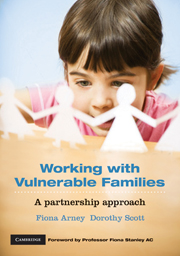Book contents
- Frontmatter
- Foreword
- Contents
- List of figures, tables and boxes
- Contributors
- Acknowledgements
- Introduction
- Chapter 1 Think child, think family, think community
- Chapter 2 Family strengths: an international perspective
- Chapter 3 Harnessing ‘resilience’ when working with children and families
- Chapter 4 Working within and between organisations
- Chapter 5 Family-centred practice in early childhood settings
- Chapter 6 Sustained nurse home visiting with families of Aboriginal children
- Chapter 7 Including fathers in work with vulnerable families
- Chapter 8 Parenting in a new culture: working with refugee families
- Chapter 9 Responding to parents with complex needs who are involved with statutory child protection services
- Chapter 10 Engaging family members in decision making in child welfare contexts
- Chapter 11 Supporting parents whose children are in out-of-home care
- Chapter 12 Using evidence-informed practice to support vulnerable families
- Chapter 13 Spreading promising ideas and innovations in child and family services
- Index
Chapter 13 - Spreading promising ideas and innovations in child and family services
- Frontmatter
- Foreword
- Contents
- List of figures, tables and boxes
- Contributors
- Acknowledgements
- Introduction
- Chapter 1 Think child, think family, think community
- Chapter 2 Family strengths: an international perspective
- Chapter 3 Harnessing ‘resilience’ when working with children and families
- Chapter 4 Working within and between organisations
- Chapter 5 Family-centred practice in early childhood settings
- Chapter 6 Sustained nurse home visiting with families of Aboriginal children
- Chapter 7 Including fathers in work with vulnerable families
- Chapter 8 Parenting in a new culture: working with refugee families
- Chapter 9 Responding to parents with complex needs who are involved with statutory child protection services
- Chapter 10 Engaging family members in decision making in child welfare contexts
- Chapter 11 Supporting parents whose children are in out-of-home care
- Chapter 12 Using evidence-informed practice to support vulnerable families
- Chapter 13 Spreading promising ideas and innovations in child and family services
- Index
Summary
Learning goals
This chapter will enable you to:
Recognise the importance of spreading good ideas in child welfare
Understand Diffusion of Innovation Theory and how it can be utilised in the transfer of programs, policies and practice in child and family services
Understand why some innovative programs and practices spread and why some fail to be adopted by child and family services
Recognise conditions under which good ideas (programs, practices, policies and ways of working) spread
Understand the facilitators of and barriers to the wider adoption of successful child and family approaches in Australia.
Introduction
The services provided by the child and family sector are broad and range from addressing the private troubles of families, including family breakdown, drug and alcohol abuse, domestic violence and mental health disorders to public issues faced by communities encompassing poverty, homelessness and unemployment. Within the sector, innovative models, programs, ideas, policies, practices, beliefs, behaviours, approaches and new ways of working continue to emerge to address these issues. A number of such innovative approaches have been described throughout this book. The provision and delivery of child and family services is constantly evolving. There is a long history of innovation in the child welfare field, ranging from the introduction of foster care in South Australia in the 1870s (Spence, 1907), the spread of the kindergarten movement in the early 20th century (Wollons, 2000), to the contemporary social marketing strategies to modify parenting behaviour.
- Type
- Chapter
- Information
- Working with Vulnerable FamiliesA Partnership Approach, pp. 275 - 296Publisher: Cambridge University PressPrint publication year: 2010
- 1
- Cited by

